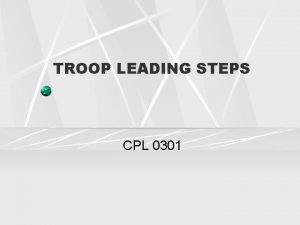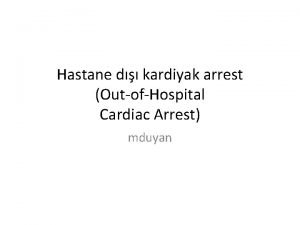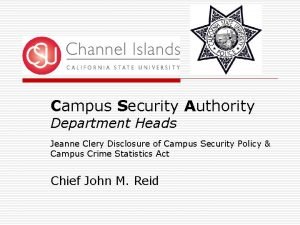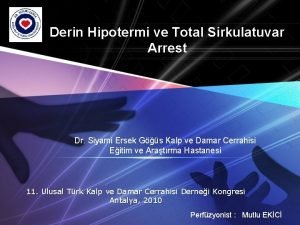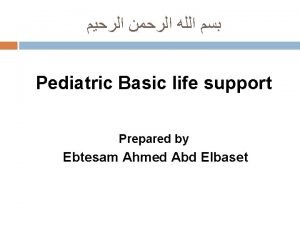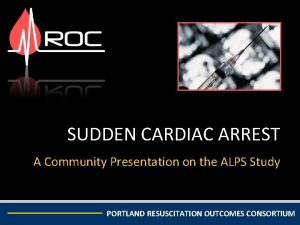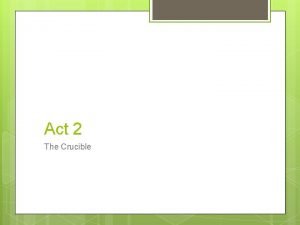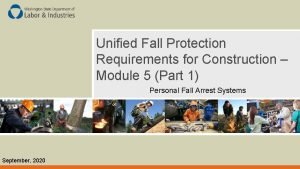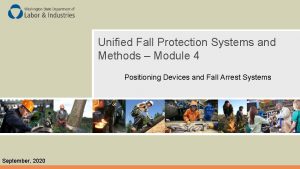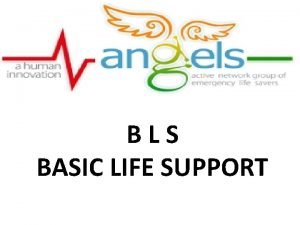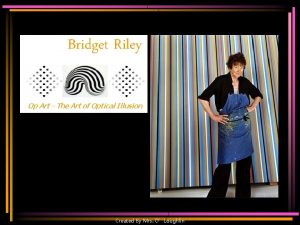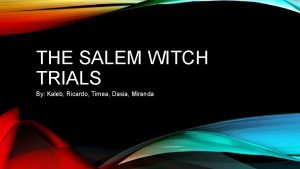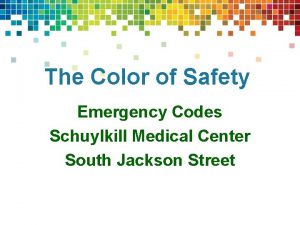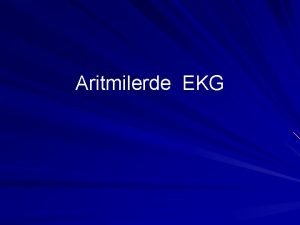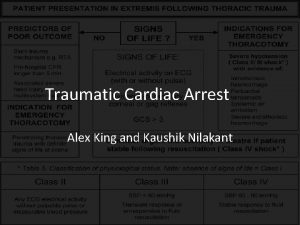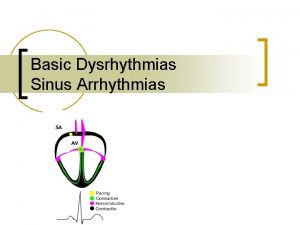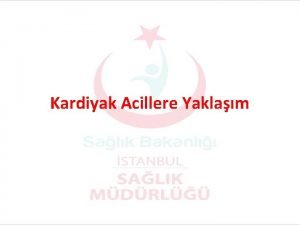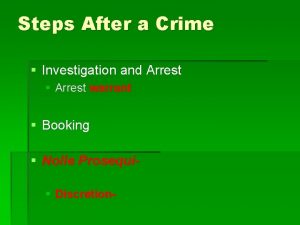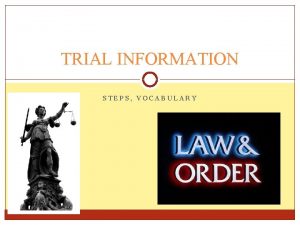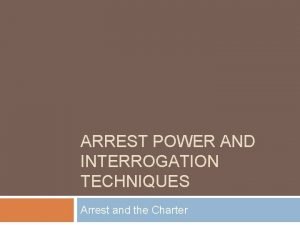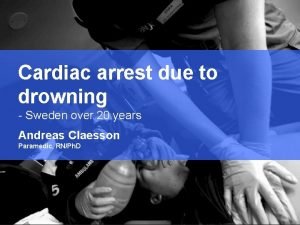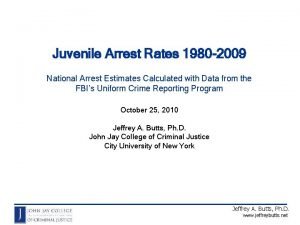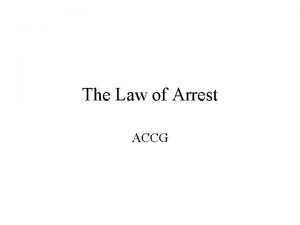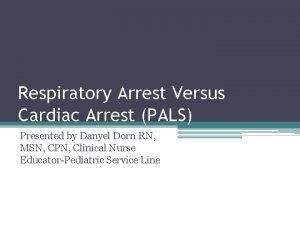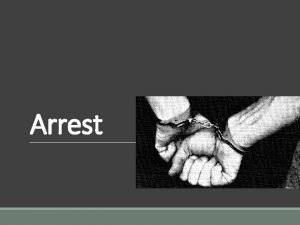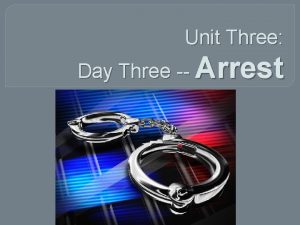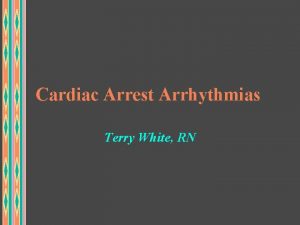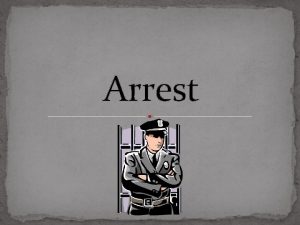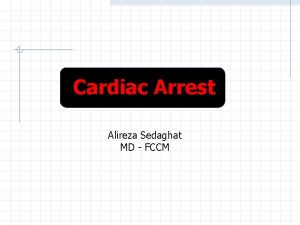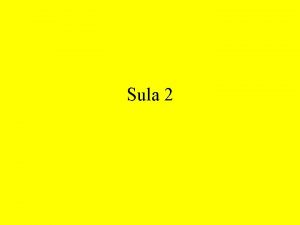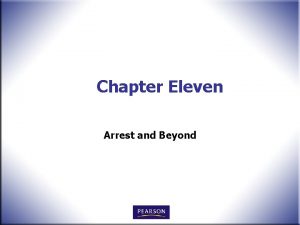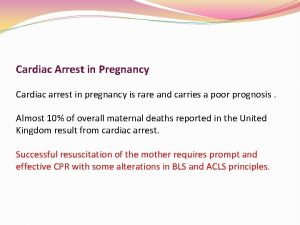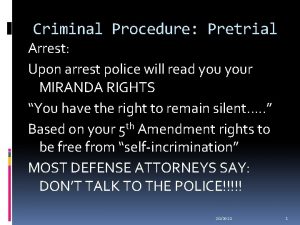Arrest To Trial Steps leading to trial 5

























- Slides: 25

Arrest To Trial

Steps leading to trial 5 stages or steps of the C. J. S • • • arrest arraignment conference trial sentencing

• http: //www. youtube. com/watch? v=i. Yqpoylpk -o


The Arrest • Initiated by Law Enforcement Agent • Probable Cause is necessary to make a legal lawful arrest • Probable cause is more than suspicion but less than certainty • Police may obtain an arrest warrant from a judge.

Arrest http: //www. youtube. com/watch? v=IEo. Pr. Cdc 4 WI&list=PLZ 57 Llpv. GX 0 b. Wos 7 Pop 4 h. X 2 e. Dl. Z 5 N 5 Rf

Arraignment appearance of the accused before a judge, at which time the charge(s) are read Arraignment must take place with reasonable speed (most states within 24 -72 hours) Writ of Habeas Corpus • an order from a judge obtained by the prisoner’s attorney requiring the police to bring the prisoner before that judge, protects against being held unjustly • Plea is entered by the prisoner: GUILTY, NOT GUILTY or NOT GUILTY BY REASON OF INSANITY – guilty - sentencing date is set • pre-sentencing investigation begins – not guilty - bail or R. O. R. is considered • trial date is set – not guilty by reason of insanity • psychiatric testing to determine whether the person is insane

Arraignment amount of bail (money) is set by judge and determined by circumstances and type of crime. If the accused can meet bail, he/she will be released pending date of trial. Money is fully returned when accused returns to court on the specified date Bail: https: //www. cnn. com/2018/08/28/us/bail-california-bill/index. html defendant released prior to the trial on the condition that he return to court whenever required to do so and that he obey and all instructions of the court R. O. R. - (Release on Own Recognizance): When a defendant is charged with offenses which are not felonies, court must order recognizance or bail. A court may not order recognizance or bail under these circumstances: 1. defendant convicted of a Class A Felony 2. defendant is charged with a Class A Felony 3. it appears defendant has 2 previous felony convictions Remand: court orders a defendant confined to jail prior to the start of his trial

Arraignment: https: //www. youtube. com/watch? v=59 Gz. Sx. W 1 e. GM&list=PLZ 57 Llpv. GX 0 b. Wos 7 Pop-4 h. X 2 e. Dl. Z 5 N 5 Rf&index=4 Vera Institute of Justice • (1961) to reform justice system in the area of bail. Not meeting bail and being sent to jail to await trial is unfair and against the 8 th amendment O. R. Program • is an investigative process; accused is asked questions pertaining to his ties to community, family, friends and work

Preliminary Arraignment • http: //www. youtube. com/watch? v=i. PZ 6 Hl 4 m 3 a 8&list=PLZ 57 Llpv. GX 0 b. Wos 7 Pop 4 h. X 2 e. Dl. Z 5 N 5 Rf&index=2

Preliminary Hearing • if charges indicate a serious misdemeanor or a felony, the accused may ask for a preliminary hearing • State will have to show that there is sufficient grounds to believe that the accused did in fact commit the crime charged (cannot decide whether or not the accused is guilty) • If no sufficient grounds for a trial, charges are dismissed (defendant is freed and bail is cancelled). • If the charge is a felony, whether or not there has been a preliminary hearing following arraignment, the entire matter is sent to the Grand Jury Purpose of the Preliminary Hearing • determine if there is sufficient evidence to warrant submitting the case to Grand Jury Rights of the Accused at Preliminary Hearing • right to counsel • right to confront witnesses • challenge evidence against him • present witnesses and evidence in own behalf

Grand Jury A Grand Jury is comprised of 12 -23 people. The purpose of a Grand Jury is to decide if there is enough evidence to determine that a felony has been committed, that the accused committed this act and there is grounds for prosecution • If at least 12 jurors believe that there is sufficient evidence for a trial, then a True Bill is returned • If it is determined that the charges are to be totally dropped a No Bill is returned • If evidence needed for a felony charge is inadequate, but sufficient for a misdemeanor, charge will be reduced and sent to criminal court on information as a misdemeanor • Grand Jury witnesses can only refuse to answer questions that violate the 5 th amendment. An indictment (support of the prosecution’s case) is not considered a conviction • After hearing and examining evidence a Grand Jury may: – – indict a person of an offense reduce charge to a non-felony dismiss charges submit a Grand Jury report

The Conference Stage Plea Bargaining: reduction of the charge is accepting a guilty plea for a lesser charge and sentence Rationale for Plea Bargaining 1. It Saves Time - no need for Grand Jury or Supreme Court actions 2. It Saves People Money – Courts and trials can be costly 3. It Saves the State Money - There is a high cost for incarceration 4. It Saves Space – There a lack of facilities to detain and maintain both the accused and criminals 5. It Saves Weak Cases – The defense or prosecution can seek Plea Bargains if they feel their case is weak due to a lack of evidence or credible witnesses.

The Trial 6 th Amendment: In all criminal prosecutions, the accused shall enjoy the right to a speedy and public trial, by an impartial jury of the State and district wherein the crime shall have been committed, which district shall have been previously ascertained by law, and to be informed of the nature and cause of the accusation; to be confronted with the witnesses against him; to have compulsory process for obtaining witnesses in his favor, and to have the Assistance of Counsel for his defense.

The Trial – THE JURY What are the eligibility requirements for Jury Duty: A) A Citizen of U. S. B) At least 18 years old. C) a resident of county you serve in D) be able to communicate in English E) not convicted of a felony *Sound mind and judgment, good character, approved integrity How are potential jurors selected? : A) lists of registered voters B) Motor Vehicle lists C) State income tax filers D) recipients of unemployment insurance or welfare E) Volunteers How often are your called for Jury Duty? - every 6 yrs. , 8 yrs. if serve for more than 10 days

The Trial – The JURY Impaneling: The Process by which jurors are selected and sworn in Voire Dire: The questioning of potential jurors by the attorneys to determine if they should serve. Lawyers have the right not to impanel a specific juror, there are 2 kinds of challenges that may be used: 1) Challenge for Cause - based on bias or prejudice in which a juror would be unable to reach a fair verdict 2) Peremptory Challenge - rejection by either attorney without having to give a reason; number is fixed at the start of questioning

The Trial – The Jury Special Circumstances A)Sequestered Jury- isolation of jury to prevent tainting or persuasion by media reports (high profile cases) B)Change of Venue- location of trial moved to find impartial jury

The Trial – Legal Aid • society founded in 1876 helping those who were too poor to afford a lawyer or had a language barrier 3 divisions of Legal Aid • Civil Division • Criminal Division • Juvenile Rights Financial Eligibility for Legal Aid • is based on gross annual income and number of dependents in the household

The Trial – People to Know Courtroom Participants Judge- ensures rules and rights are respected Prosecutor- conduct criminal proceeding for the State Defense Counsel- defends the accused Bailiff- officer that keeps order in the court Stenographer- keeps records of the courtroom proceeding Court Clerk- organizes records and files of the courtroom proceedings Lay witness- common person that may have evidence to a crime Expert witness- professionals that can give opinions in their area of expertise.

Courtroom Procedures Trial Opening Statements: give the jury an overview of what they are about to hear.

Objections: During trial, each party may call witnesses to testify on its behalf. Each party, through its attorney, poses questions to the witness, who then answers. During testimony, any attorney may object. An objection is a request that the judge disallows a question, limit the testimony, or instruct a witness to give a complete answer to a question. An objection—if made correctly—is made immediately after the question is asked and before the witness answers. Occasionally, objections are made to a witness’ testimony as well. Generally, in the course of trial, the judge rules on the objection by either sustaining or overrule/denying it. Sustained: Judge agrees with the attorney’s objection and disallows the question. Overruled: Judge does not recognize the objection and valid and the examination can continue.

Objections to the FORM of the Question: Form: Leading, Asked and Answered, Speculation, Argumentative, Badgering, Confusing Objections to the SUBSTANCE of the Question Substance: Lacks foundation, Assumes Facts, Irrelevant, Hearsay

Direct Examination- lawyer initially questions own witness Cross-examination- questioning of witness by opposing lawyer Re-direct examination-lawyer questions own witness again (damage control) Re-cross examination-opposing lawyer responds to re-direct exam. Subpoena- official document summoning a witness to testify. Deliberations- jury’s discussion of innocence or guilt Verdict- jury’s final decision Mistrial or “Hung Jury”- one that can’t agree; mistrial declared!


Type of Jury Function Number of people Grand Jury Decided if accused is indicted- sent to trial Regular Jury (Petit) Decided the verdictinnocence or guilt of accused 16 -23 12 When in use Before a trial During a trial Types of cases heard Felonies & Federal crimes All crimes & civil suits Number required for decision 2/3 majority unanimous Constitutional Amendment that guarantees it 5 th Amendment 6 th Amendment Can defendant waive right to it? Yes, bench trial instead; judge decides
 Bobbin leading and flyer leading
Bobbin leading and flyer leading Troop leading procedures
Troop leading procedures Gary goulin arrest
Gary goulin arrest Gary goulin arrest
Gary goulin arrest Sinus pause
Sinus pause Hastane dışı kardiyak arrest
Hastane dışı kardiyak arrest Cipd arrest report
Cipd arrest report Derin hipotermik sirkülatuar arrest
Derin hipotermik sirkülatuar arrest Paediatric assessment triangle
Paediatric assessment triangle Cause of cardiac arrest
Cause of cardiac arrest Mary warren conflict
Mary warren conflict Personal fall arrest snap hooks must be locking and be
Personal fall arrest snap hooks must be locking and be Fall protection methods
Fall protection methods Adult chain of survival
Adult chain of survival Bridget riley descending
Bridget riley descending Severe dka criteria
Severe dka criteria Respiratory arrest definition
Respiratory arrest definition Dr douglas vaughan
Dr douglas vaughan What sort of evidence was used to arrest accused witches
What sort of evidence was used to arrest accused witches Hospital code colors
Hospital code colors Silver diamine fluoride bottle
Silver diamine fluoride bottle Sinuzal arrest
Sinuzal arrest Kaushik arrest
Kaushik arrest Ketouria
Ketouria Ecg rhythm strip interpretation, basic lesson 6
Ecg rhythm strip interpretation, basic lesson 6 şoklanan ritimler
şoklanan ritimler

